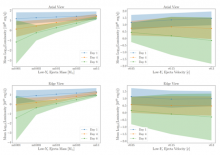
Abstract
Depending upon the properties of their compact remnants and the physics included in the models, simulations of neutron star mergers can produce a broad range of ejecta properties. The characteristics of this ejecta, in turn, define the kilonova emission. To explore the effect of ejecta properties, we present a grid of 2-component 2D axisymmetric kilonova simulations that vary mass, velocity, morphology, and composition. The masses and velocities of each component vary, respectively, from 0.001 to 0.1 M⊙ and 0.05 to 0.3c, covering much of the range of results from the neutron star merger literature. The set of 900 models is constrained to have a toroidal low electron fraction (Ye) ejecta with a robust r-process composition and either a spherical or lobed high-Ye ejecta with two possible compositions. We simulate these models with the Monte Carlo radiative transfer code SuperNu using a full suite of lanthanide and 4th row element opacities. We examine the trends of these models with parameter variation, show how it can be used with statistical tools, and compare the model light curves and spectra to those of AT2017gfo, the electromagnetic counterpart of GW170817.